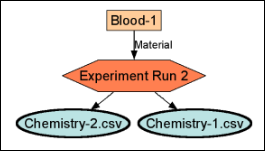The run builder captures experiment processes by linking together 1) a set of inputs, 2) a process or "run", and 3) a set of outputs. This user-friendly tool prompts the user for information about the run: the inputs (samples and/or files), metadata on the run that was performed, and the output (samples and/or files). Any combination of samples and files can be linked to a run, either as inputs or outputs, making this a flexible tool that can be applied to many use cases.
The run builder can be useful for capturing "at the bench" experimental information. For example, a lab technician might use the run builder to record that a process has happened, where samples were the input and files were the output. The run builder lets you form relationships between individual input samples/files (or any other LSID record) with individual outputs. In the run depicted below, a blood sample is the input to the experiment and two CSV files form the output:

Samples and files may be selected from those already loaded onto the server, or created during the run building process. Run inputs and outputs create lineage/parentage relationships, which are reflected in the lineage views as parents (inputs) and children (outputs).
Once they are related within a run, the files and samples cannot be deleted without first deleting the run.
Note that the "runs" referred to here are experiment runs, not be confused with Assay runs.
To enable the run builder, you must enable both the provenance and experiment modules within the container where you plan to use it.
You can use the Run Builder to create runs from within the experiment module, from a sample grid, from the file browsers, or directly using the URL.
You can access the run builder from the Experiment Runs menu bar. If your folder does not already include this web part, add "Experiment Runs" to your page, or select > Go To Module > Experiment.

Proceed to define properties, inputs, and outputs for your run.
Viewing the list of samples in a Sample Type, you can also select the desired samples and use Create Run > Input Samples or Output Samples depending on how you want the samples included in the run you build:
When the run builder opens, it will be prepopulated with the samples you selected, in either the Inputs or Outputs section. You can add additional samples and files before saving the run.
When the provenance module is enabled, the file browser includes a Create Run button. Access it via the Files web part or > Go To Module > FileContent.
Select the file of interest using the checkbox and click Create Run. In the popup, select either Inputs or Outputs depending on which section should include the chosen file(s). Click Create Run.
The run builder will open with the chosen files prepopulated in the selected section. You can add additional files and samples to the run before saving.
The run builder can also be accessed directly via the URL. Navigate to the desired container and replace the end of the URL with:
provenance-runBuilder.view?
In the Properties section, give your run a name, enter a description, and add any Vocabulary Properties with values that you need. These values will be applied to the run as a whole, not to individual inputs or outputs.
Under Inputs and Outputs, add the samples and files required.
You can Save while building the run, and click Save & Finish when finished.

To add samples, either to the Inputs or Outputs section of the run builder, click the Add Samples button.
You can add samples in two ways:
You can filter, sort, or search to locate the samples you want to include. Click in the box to use it to locate your samples of interest.
Check the boxes for the desired samples and click Add Samples. The samples you added will now appear in a grid in the run builder:
You can now click Add Samples to add more, Move Selected Samples to Output or if necessary, select and Remove Selected Samples.
You can Save work in progress while building the run, and click Save & Finish when finished.
Click Add Files to choose files to add to either the input or output sections. Use the File Select tab to browse the file root for files already uploaded. Use the checkboxes to select one or more files to add to the run you are building.
Click the File Upload tab to switch to a drag-and-drop interface for uploading new files.
Click Add Files when ready.
The files you've added will be listed, each with a for deleting. Click Add Files to add more as needed.
You can Save work in progress while building the run, and click Save & Finish when finished.
Runs created by the run builder are available on the Experiment Runs web part. Click the name to see run details; click the graph icon to the left of the run name to go directly to the lineage graph for this run. Learn more in this topic:

To edit a run, you can reopen the Run Builder interface by clicking Edit Run from the run details page.
Make the necessary changes and click Save & Finish.